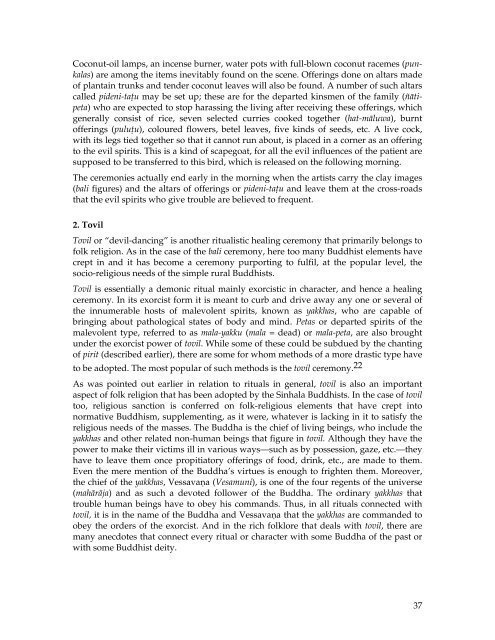Buddhist Ceremonies and Rituals of Sri Lanka
Buddhist Ceremonies and Rituals of Sri Lanka
Buddhist Ceremonies and Rituals of Sri Lanka
You also want an ePaper? Increase the reach of your titles
YUMPU automatically turns print PDFs into web optimized ePapers that Google loves.
Coconut-oil lamps, an incense burner, water pots with full-blown coconut racemes (punkalas)<br />
are among the items inevitably found on the scene. Offerings done on altars made<br />
<strong>of</strong> plantain trunks <strong>and</strong> tender coconut leaves will also be found. A number <strong>of</strong> such altars<br />
called pideni-taþu may be set up; these are for the departed kinsmen <strong>of</strong> the family (ñátipeta)<br />
who are expected to stop harassing the living after receiving these <strong>of</strong>ferings, which<br />
generally consist <strong>of</strong> rice, seven selected curries cooked together (hat-máluwa), burnt<br />
<strong>of</strong>ferings (puluþu), coloured flowers, betel leaves, five kinds <strong>of</strong> seeds, etc. A live cock,<br />
with its legs tied together so that it cannot run about, is placed in a corner as an <strong>of</strong>fering<br />
to the evil spirits. This is a kind <strong>of</strong> scapegoat, for all the evil influences <strong>of</strong> the patient are<br />
supposed to be transferred to this bird, which is released on the following morning.<br />
The ceremonies actually end early in the morning when the artists carry the clay images<br />
(bali figures) <strong>and</strong> the altars <strong>of</strong> <strong>of</strong>ferings or pideni-taþu <strong>and</strong> leave them at the cross-roads<br />
that the evil spirits who give trouble are believed to frequent.<br />
2. Tovil<br />
Tovil or “devil-dancing” is another ritualistic healing ceremony that primarily belongs to<br />
folk religion. As in the case <strong>of</strong> the bali ceremony, here too many <strong>Buddhist</strong> elements have<br />
crept in <strong>and</strong> it has become a ceremony purporting to fulfil, at the popular level, the<br />
socio-religious needs <strong>of</strong> the simple rural <strong>Buddhist</strong>s.<br />
Tovil is essentially a demonic ritual mainly exorcistic in character, <strong>and</strong> hence a healing<br />
ceremony. In its exorcist form it is meant to curb <strong>and</strong> drive away any one or several <strong>of</strong><br />
the innumerable hosts <strong>of</strong> malevolent spirits, known as yakkhas, who are capable <strong>of</strong><br />
bringing about pathological states <strong>of</strong> body <strong>and</strong> mind. Petas or departed spirits <strong>of</strong> the<br />
malevolent type, referred to as mala-yakku (mala = dead) or mala-peta, are also brought<br />
under the exorcist power <strong>of</strong> tovil. While some <strong>of</strong> these could be subdued by the chanting<br />
<strong>of</strong> pirit (described earlier), there are some for whom methods <strong>of</strong> a more drastic type have<br />
to be adopted. The most popular <strong>of</strong> such methods is the tovil ceremony. 22<br />
As was pointed out earlier in relation to rituals in general, tovil is also an important<br />
aspect <strong>of</strong> folk religion that has been adopted by the Sinhala <strong>Buddhist</strong>s. In the case <strong>of</strong> tovil<br />
too, religious sanction is conferred on folk-religious elements that have crept into<br />
normative Buddhism, supplementing, as it were, whatever is lacking in it to satisfy the<br />
religious needs <strong>of</strong> the masses. The Buddha is the chief <strong>of</strong> living beings, who include the<br />
yakkhas <strong>and</strong> other related non-human beings that figure in tovil. Although they have the<br />
power to make their victims ill in various ways—such as by possession, gaze, etc.—they<br />
have to leave them once propitiatory <strong>of</strong>ferings <strong>of</strong> food, drink, etc., are made to them.<br />
Even the mere mention <strong>of</strong> the Buddha’s virtues is enough to frighten them. Moreover,<br />
the chief <strong>of</strong> the yakkhas, Vessavaóa (Vesamuni), is one <strong>of</strong> the four regents <strong>of</strong> the universe<br />
(mahárája) <strong>and</strong> as such a devoted follower <strong>of</strong> the Buddha. The ordinary yakkhas that<br />
trouble human beings have to obey his comm<strong>and</strong>s. Thus, in all rituals connected with<br />
tovil, it is in the name <strong>of</strong> the Buddha <strong>and</strong> Vessavaóa that the yakkhas are comm<strong>and</strong>ed to<br />
obey the orders <strong>of</strong> the exorcist. And in the rich folklore that deals with tovil, there are<br />
many anecdotes that connect every ritual or character with some Buddha <strong>of</strong> the past or<br />
with some <strong>Buddhist</strong> deity.<br />
37

















